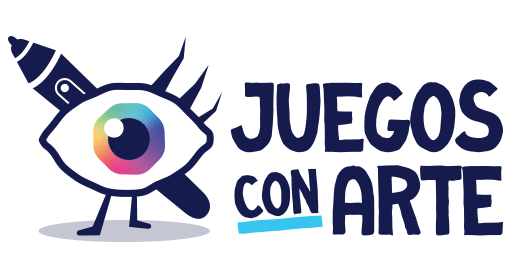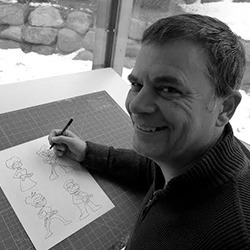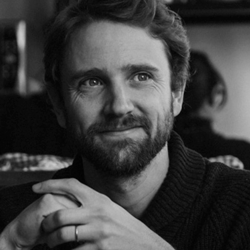
Queremos abrir esta nueva temporada de entrevistas con el cineasta y diseñador de juegos Malachi Ray Rempen, responsable de la creación e ilustración del juego de mesa Cámara Roll, traído en castellano gracias a la editorial Salt & Pepper Games.
Os dejamos con la entrevista, no olvidéis compartir la entrevista si te ha gustado 😉.
ENG | Welcome Malachi, thanks for collaborating with us! For our readers who don’t know your work, could you tell us a little about yourself and how you got into the world of board games?
Hello readers. My background is filmmaking – I’ve been making films or involved variously with the film industry in the US and Europe since I was 10 years old. I’ve also been a hobbyist cartoonist and illustrator my whole life, though I never studied or trained formally in illustration.
When I moved to Europe in 2011, I started a weekly web comic, Itchy Feet, mostly as a way to share my experiences and thoughts with friends and family. But the comic took off, and after 5-6 years I had well over 100k followers across social media. So in brainstorming ideas for merchandise tied to the comic, one of my friends suggested a card game. Exploding Kittens had just come out, by the Oatmeal guy, so I thought I could do the same. I’ve always played video games and a few board games as a kid, but at that time I had no idea the extent of the tabletop board game hobby.
I launched Itchy Feet: the Travel Game on Kickstarter in 2017 and it raised waaaaaayyy more than I expected. Like, 10x more. So naturally I wanted to follow it up with another game. Filmmaking as I said is a subject I’m very close to, and I had not seen it represented properly in board games before. So I launched Roll Camera, that did even better than Itchy Feet, and now I can’t stop making games!
ESP | Bienvenido Mal, ¡gracias por colaborar con nosotros! Para nuestros lectores que no conozcan tu trabajo, ¿podrías hablarnos un poco de ti y de cómo llegaste al mundo de los juegos de mesa?
Hola lectores. Mi formación es cinematográfica: he estado haciendo películas o participando en la industria del cine en Estados Unidos y Europa desde que tenía 10 años. También he sido dibujante e ilustrador aficionado toda mi vida, aunque nunca estudié ni me formé formalmente en ilustración.
Cuando me mudé a Europa en 2011, empecé un cómic web semanal, Itchy Feet, principalmente como una forma de compartir mis experiencias y pensamientos con amigos y familiares. Pero el cómic despegó y, al cabo de 5 o 6 años, tenía más de 100k seguidores en las redes sociales. Así que, en una lluvia de ideas sobre productos relacionados con el cómic, uno de mis amigos sugirió un juego de cartas. Acababa de salir Exploding Kittens, del tipo Oatmeal, así que pensé que podría hacer lo mismo. Siempre he jugado a videojuegos y a algunos juegos de mesa de niño, pero entonces no tenía ni idea de la magnitud de la afición a los juegos de mesa.
Lancé Itchy Feet: the Travel Game en Kickstarter en 2017 y recaudó waaaaaayyy más de lo que esperaba. Como 10 veces más. Así que, naturalmente, quería seguir con otro juego. El cine, como he dicho, es un tema al que estoy muy unido, y no lo había visto representado adecuadamente en juegos de mesa antes. Así que lancé Cámara Roll, que funcionó incluso mejor que Itchy Feet, ¡y ahora no puedo parar de hacer juegos!
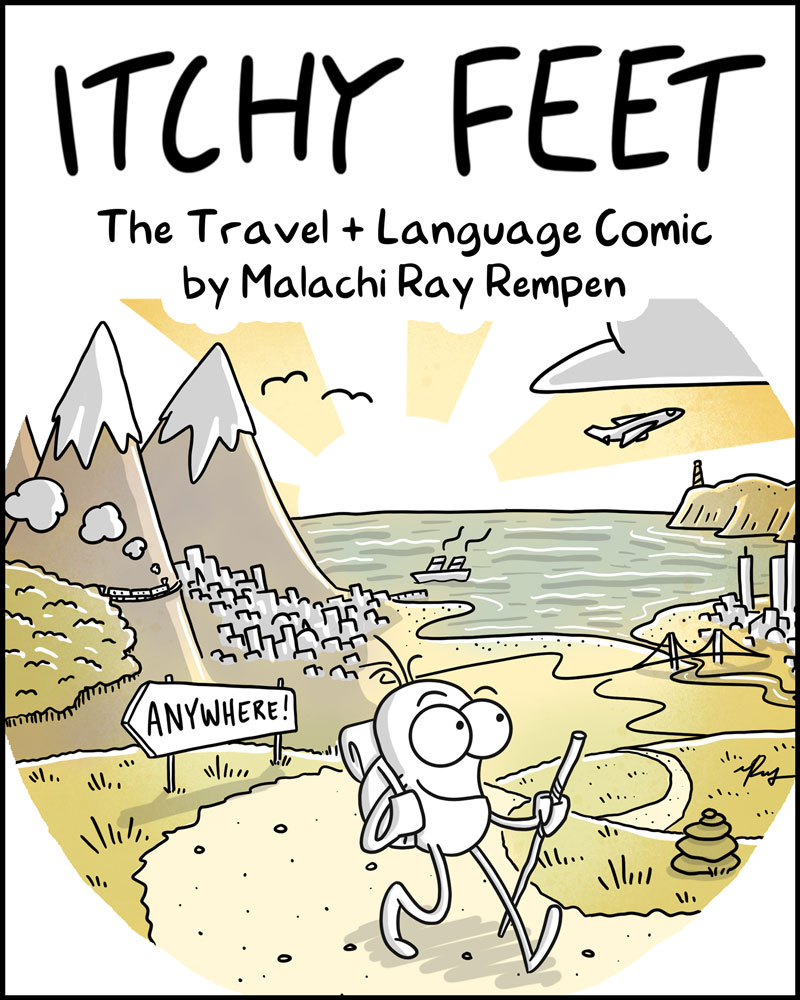
ENG | Roll Camera is a board game in which we will be film producers looking for our last chance to make a successful movie. What came first, the mechanics or the theme? How did you come up with such an original theme?
I am 100% a theme-first designer. My brain does not think very well in terms of mechanisms – if I come up with a mechanism that clashes with the theme it immediately bothers me. There are certain mechanisms in Roll Camera (like rolling your crew dice) that are not accurate to real life, but the FEELING is accurate to shooting a film, and that I think is what a good thematic board game is. It’s not an action simulator, it’s a feeling machine.
The theme just came from inside me, really, and being lucky that no one had tackled the same theme in quite that way before.
ESP | Roll Camera es un juego de mesa en el que seremos productores de cine en busca de nuestra última oportunidad para hacer una película de éxito. ¿Qué fue primero, la mecánica o el tema? ¿Cómo se le ocurrió un tema tan original?
Soy un diseñador 100% temático. Mi cerebro no piensa muy bien en términos de mecanismos: si se me ocurre un mecanismo que choca con el tema, me molesta inmediatamente. Hay ciertos mecanismos en Roll Camera (como tirar los dados de tu equipo) que no son fieles a la vida real, pero la SENSACIÓN es fiel al rodaje de una película, y eso creo que es lo que es un buen juego de mesa temático. No es un simulador de acciones, es una máquina de sentimientos.
El tema surgió de mi interior, en realidad, y de la suerte de que nadie antes hubiera abordado el mismo tema de esa manera.
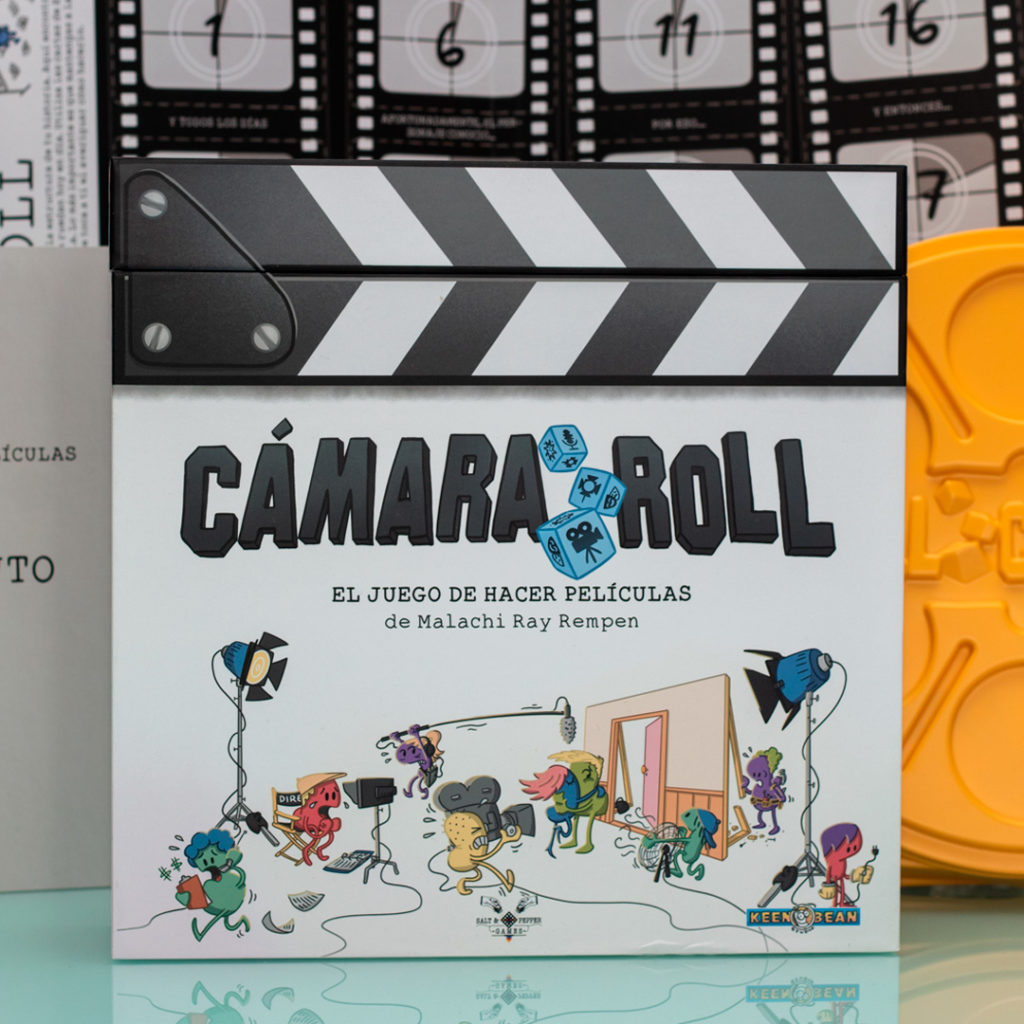
ENG | As an author and illustrator you were able to participate in the whole process, what steps did you follow for its creation and development? From the first ideas to the final personal artwork.
My first draft of the game really tried too hard to replicate filmmaking as a process. It was too simulationist, and not very fun. For my second attempt I wanted to take inspiration from another game, and I found that in Tony Go’s excellent Deep Space D-6, a solo game where you operate a space ship. Like Roll Camera, you have crew dice which have the faces of the different ship crew departments like engineering, weapons or captain, and you assign them around your space ship to try to defeat enemies. That worked for filmmaking too, so with Tony’s permission I borrowed that core mechanism.
The rest of it was built out on Tabletop Simulator and also physically on the backs of pizza boxes and scrap paper. I knew I was making progress when people got excited during and after playing it, even while the design looked like crap. Once the design started feeling settled, I started adding artwork and refined the iconography. I did a few different passes with various styles because I wasn’t sure initially what the «look» of the game would be, aside from bean-people of course. And that work continued even after the campaign finished. It’s great to get feedback from backers as the game is going along. And their excitement really helped me push it over the finish line.
ESP | Como autor e ilustrador pudiste participar en todo el proceso, ¿qué pasos seguiste para su creación y desarrollo? Desde las primeras ideas hasta las ilustraciones personales finales.
Mi primer borrador del juego se esforzaba demasiado por imitar el proceso cinematográfico. Era demasiado simulacionista y no muy divertido. Para mi segundo intento quise inspirarme en otro juego, y lo encontré en el excelente Deep Space D-6 de Tony Go, un juego en solitario en el que manejas una nave espacial. Al igual que Cámara Roll, tienes dados de tripulación que tienen las caras de los distintos departamentos de la tripulación de la nave, como ingeniería, armas o capitán, y los asignas alrededor de tu nave espacial para intentar derrotar a los enemigos. Eso también funcionaba para hacer películas, así que, con el permiso de Tony, tomé prestado ese mecanismo central.
El resto se construyó en Tabletop Simulator y también físicamente en el reverso de cajas de pizza y papel. Sabía que estaba progresando cuando la gente se emocionaba durante y después de jugar, incluso cuando el diseño parecía una mierda. Una vez que el diseño se fue asentando, empecé a añadir ilustraciones y a perfeccionar la iconografía. Hice varias pasadas con distintos estilos, porque al principio no estaba seguro de cuál sería el «aspecto» del juego, aparte de los frijoleros, claro. Y ese trabajo continuó incluso después de que terminara la campaña. Es genial recibir comentarios de los patrocinadores a medida que el juego avanza. Y su entusiasmo me ayudó a sacarlo adelante.

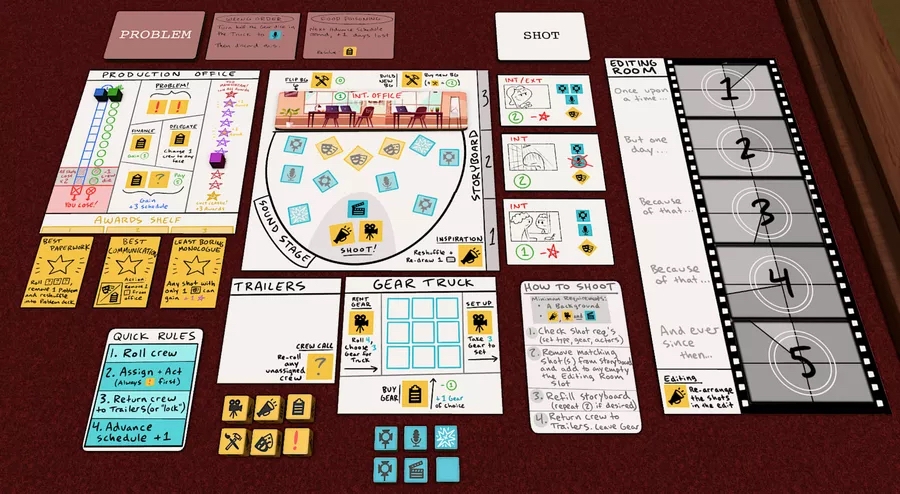
ENG | During the prototyping and development phases, which parts were the most complex and how did you solve them?
Because the design was built on the core of a solo game, it was a while before I got the multiplayer interaction working. It was a challenge to get the idea cards working as a proper interactive mechanism, something that’s interesting even when it’s not your turn. Keeping idea cards secret and then «pitching» them turned out to be the key.
Another challenge in the design was the Editing Room. I knew I wanted it to be mechanically important for the scenes to be in a particular order; it felt wrong if it didn’t matter at all. Initially the scenes had adjacency bonuses and penalties, which I think is closer to real filmmaking – whether a scene goes before or after another scene can often completely change the movie – but visually it was too difficult for players to parse the iconography. I then saw another board game where scoring tiles are laid out at setup, and I had the idea for the Script, which offers bonuses or penalties based on how your Scenes are arranged in the Editing Room. This I think works pretty well.
ESP | Durante las fases de prototipado y desarrollo, ¿qué partes fueron las más complejas y cómo las resolviste?
Como el diseño partía de la base de un juego en solitario, tardé un tiempo en conseguir que funcionara la interacción multijugador. Fue todo un reto conseguir que las cartas de ideas funcionaran como un mecanismo interactivo adecuado, algo que resultara interesante incluso cuando no fuera tu turno. Mantener las cartas de ideas en secreto y luego «lanzarlas» resultó ser la clave.
Otro reto en el diseño fue la Sala de Edición. Sabía que quería que las escenas estuvieran en un orden determinado desde el punto de vista mecánico. Al principio, las escenas tenían bonificaciones y penalizaciones por adyacencia, lo que creo que se acerca más a la realidad cinematográfica (que una escena vaya antes o después de otra puede cambiar por completo la película), pero visualmente era demasiado difícil para los jugadores analizar la iconografía. Entonces vi otro juego de mesa en el que las fichas de puntuación se colocan en el momento de la preparación, y se me ocurrió la idea del Guión, que ofrece bonificaciones o penalizaciones en función de cómo estén dispuestas las escenas en la Sala de Montaje. Creo que funciona bastante bien.

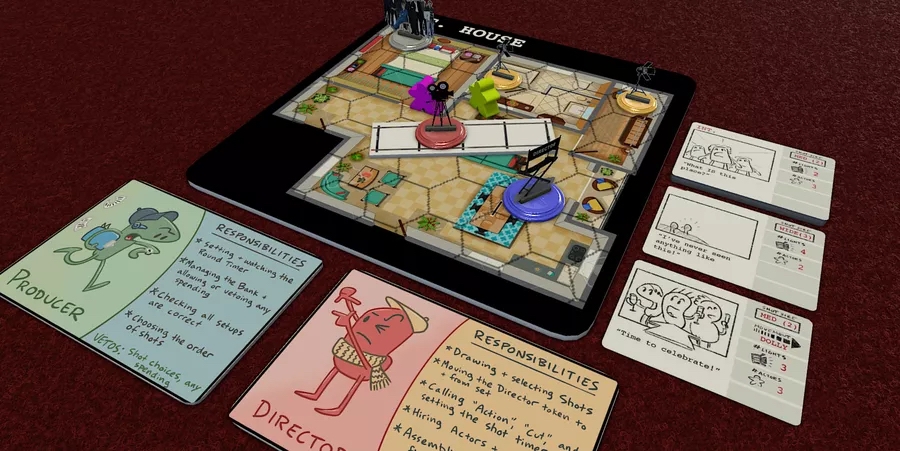
ENG | Let’s talk about the personal artwork in Roll Camera, tell us about your inspiration and references when using these cute characters?
The characters in Roll Camera are derived from the characters in my comic Itchy Feet, and those characters came initially from a one-off comic I did in high school called Bad Luck Spleen, about a spleen that walked around and bad violent things happened to whomever he met. I thought it was funny.
When I started Itchy Feet I wanted some kind of character that was a bit different than a stick person or a fully rendered human, so I went with the spleen, but of course it didn’t look much like a real spleen so people kept calling him a bean. That’s where the name for my company, Keen Bean Studio, came from.
With Roll Camera I wanted an art style that was similar enough to Itchy Feet that hopefully it would draw the Itchy Feet crowd, but different enough that it felt like its own thing. That’s why the characters in Roll Camera are multicolored, where in Itchy Feet they’re black and white. I don’t know if I’ll keep doing bean-people artwork for all my future games, but short term I’ll probably stick with them since they’re pretty recognizable.
ESP | Hablemos de las ilustraciones tan personales de Roll Camera, ¿cuéntenos en qué se inspiró y cuáles fueron sus referencias a la hora de utilizar estos simpáticos personajes?
Los personajes de Cámara Roll derivan de los personajes de mi cómic Itchy Feet, y esos personajes surgieron inicialmente de un cómic aislado que hice en el instituto llamado Bad Luck Spleen, sobre un bazo que iba por ahí y al que le pasaban cosas malas y violentas. Me pareció divertido.
Cuando empecé con Itchy Feet, quería un personaje que no fuera con forma humana o una persona 100% real, así que opté por el bazo, pero, claro, no se parecía mucho a un bazo de verdad, así que la gente seguía llamándolo judía. De ahí surgió el nombre de mi empresa, Keen Bean Studio.
Con Cámara Roll quería un estilo artístico lo bastante parecido a Itchy Feet para atraer al público de Itchy Feet, pero lo bastante diferente como para que pareciera algo propio. Por eso los personajes de Cámara Roll son multicolores, mientras que en Itchy Feet son en blanco y negro. No sé si seguiré haciendo las ilustraciones de los frijoles en todos mis juegos futuros, pero a corto plazo probablemente seguiré con ellos, ya que son bastante reconocibles.

ENG | While playing we can see these characters illustrated in very funny and crazy scenes in the problem and idea cards, inspired by real cases in the industry. What references and inspiration have you used to create these problem and idea cards? Which one would you say is your favorite?
My favorite reference is the Idea card where you use a NASA satellite lens. This was inspired by a true story: Stanley Kubrick was making Barry Lyndon, which is set in the 18th century, using only natural lighting. Today we’re spoiled by smartphones that can shoot by moonlight, but in 1975 you simply could not shoot a film by candlelight. So, Kubrick went to NASA, who were used to making extremely light-sensitive lenses, and repurposed one of those for the film.
Another one I like is the Problem card where someone left the storyboard in a taxi. This really happened to director Guillermo del Toro; during pre-production on Pan’s Labyrinth he left his visual bible (basically a giant book with the script, storyboard, concept art, and references) in a taxi, and has said that if the taxi driver hadn’t seen it and realized how important it was and returned it, the film would not have been made – that’s how important this document was.
But I tried to avoid parodying any specific movie scenes for the scene cards, or doing caricatures of real actors. I wanted the game to feel a bit more timeless than that, and I wanted the movie that results to be driven by your imagination rather than by actual films that some other person has already made.
ESP | Mientras jugamos podemos ver a estos personajes ilustrados en escenas muy divertidas y alocadas en las cartas de problemas e ideas, inspiradas en casos reales del sector. ¿Qué referencias e inspiración has utilizado para crear estas cartas de problemas e ideas? ¿Cuál diría que es su favorita?
Mi referencia favorita es la Carta de Idea en la que se utiliza una lente de satélite de la NASA. Está inspirada en una historia real: Stanley Kubrick estaba rodando Barry Lyndon, ambientada en el siglo XVIII, con iluminación natural. Hoy en día tenemos smartphones que filman a la luz de la luna, pero en 1975 no se podía rodar una película a la luz de una vela. Así que Kubrick recurrió a la NASA, que estaba acostumbrada a fabricar objetivos extremadamente sensibles a la luz, y reutilizó uno de ellos para la película.
Otra que me gusta es la Carta de Problemas, en la que alguien se dejó el guión gráfico en un taxi. Esto le ocurrió realmente al director Guillermo del Toro; durante la preproducción de El laberinto del fauno se dejó su biblia visual (básicamente un libro gigante con el guión, el storyboard, el arte conceptual y referencias) en un taxi, dijo que si el taxista no lo hubiera visto y se hubiera dado cuenta de lo importante que era y lo hubiera devuelto, la película no se habría hecho; así de importante era este documento.
Pero intenté evitar parodiar escenas de películas concretas para las tarjetas de escena, o hacer caricaturas de actores reales. Quería que el juego pareciera un poco más atemporal y que la película resultante se basara en tu imaginación y no en películas reales que ya hubiera hecho otra persona.

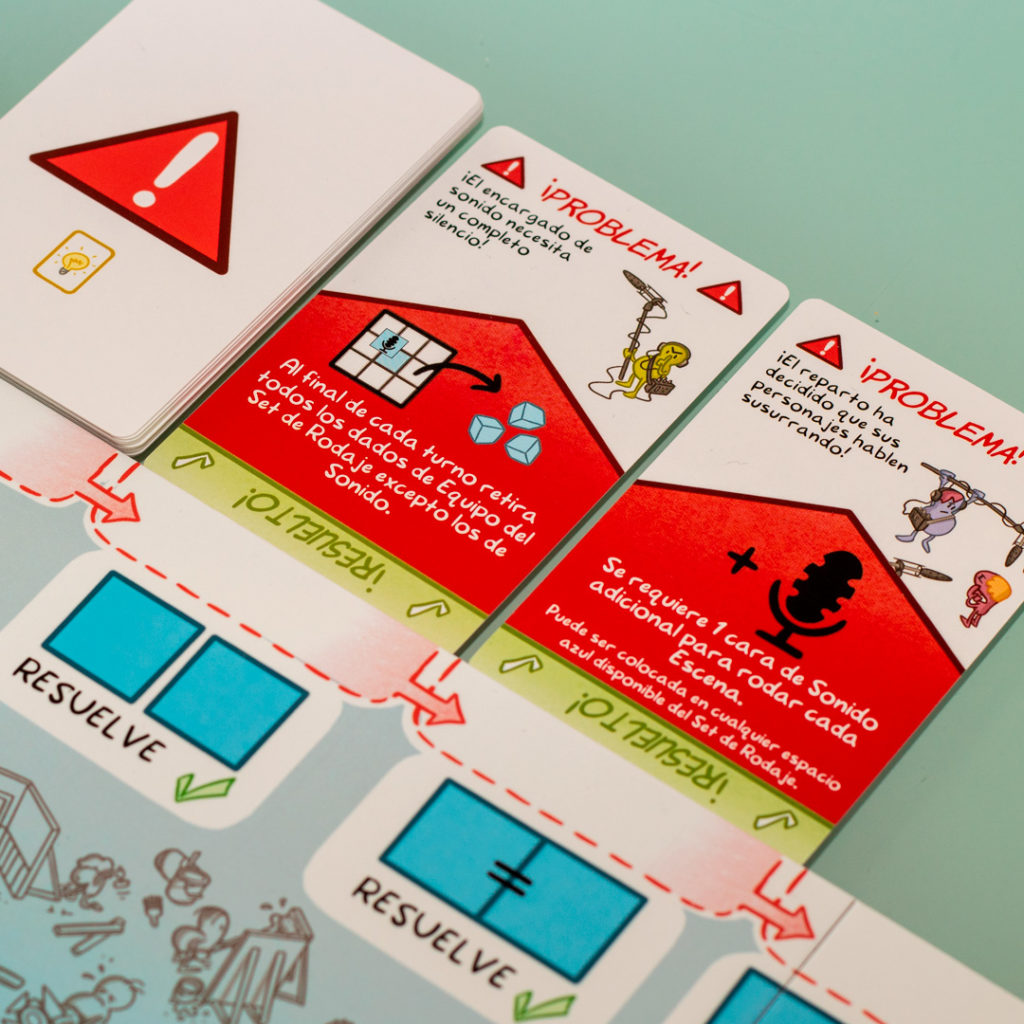
ENG | We know that creating a game and setting up the crowdfunding campaign is a big challenge. What lessons have you learned from the whole Roll Camera process?
I’ve learned to do your research – Jamey Stegmaier’s blog and the Board Game Design Lab podcast were two major sources, although I devoured anything and everything about crowdfunding and board games before launching. I learned a lot about paper and cardboard types, which was new to me. I learned about color and how it works in printed material – very very different than how it works in filmmaking, especially the digital kind! I learned how to set my expectations for the pipeline of future projects, like how long it typically takes to get from printing to freight to warehouses, etc.
I learned how to set up and run a booth at a convention, which I’ve now done three times at Essen, once at BerlinCon and once at GenCon. And I’ve learned that I don’t have to do it all by myself, and it’s probably best if I don’t! This is why I brought on the excellent John Velgus to develop the B-Movie Expansion to Roll Camera. Like with filmmaking, sometimes the most rewarding thing about the creative process is working with other people who are better than you.
ESP | Sabemos que crear un juego y poner en marcha la campaña de crowdfunding es un gran reto. ¿Qué lecciones has aprendido de todo este proceso?
He aprendido a investigar: el blog de Jamey Stegmaier y el podcast Board Game Design Lab fueron dos fuentes importantes, aunque devoré todo lo relacionado con la financiación colectiva y los juegos de mesa antes de lanzarme. Aprendí mucho sobre tipos de papel y cartón, algo nuevo para mí. Aprendí sobre el color y cómo funciona en el material impreso, muy diferente de cómo funciona en el cine, ¡especialmente en el digital! Aprendí a establecer mis expectativas para futuros proyectos, como el tiempo que se tarda normalmente en pasar de la impresión al transporte, a los almacenes, etc.
He aprendido a montar y gestionar un stand en una convención, cosa que ya he hecho tres veces en Essen, una en la BerlinCon y otra en la GenCon. Y he aprendido que no tengo que hacerlo todo yo solo, ¡y probablemente sea mejor que no lo haga! Por eso contraté al excelente John Velgus para que desarrollara la expansión de películas de serie B para Roll Camera. Al igual que ocurre con el cine, a veces lo más gratificante del proceso creativo es trabajar con otras personas que son mejores que tú.
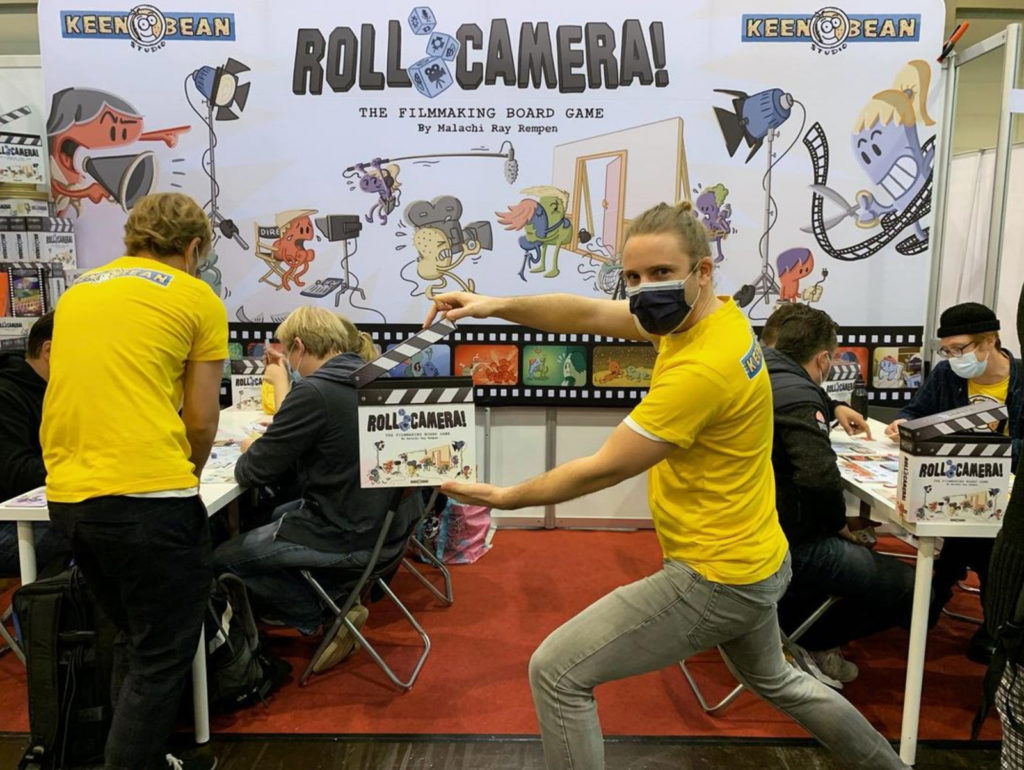
ENG | For us it is a game where the theme and mechanics fit very well and really create situations where you feel like you are shooting a movie. What would you say are the keys to get that feeling in game design?
What I noticed during playtesting of Roll Camera is that people talk to each other during the game like filmmakers.
They say:
«do we have enough money to shoot that scene? I’ve got a good idea, but it’s going to require some extra crew,» etc.
If it were another board game it would be something like «I need some extra scene tokens to activate the shooting track, so I’ll exhaust my bonus card» etc etc. So I think when people say that Roll Camera is thematic, what they mean is that they feel like they’re making a movie while playing, and they feel that way because they’re using the right language.
My favorite game designer, Cole Wehrle, has a concept he calls «strong nouns and strong verbs,» which I recently learned about. His take is, you need your game to have strong nouns – the objects in the game – and strong verbs – the actions in the game. In Roll Camera, the components match the filmmaking nouns – Scenes, Ideas, Problems, the Editing Room, the Storyboard, Set Pieces, etc. And the actions match the filmmaking verbs: shooting is an action, rearranging the set is an action, editing is an action, resolving problems or holding a production meeting are actions, and so on. I think that’s why it works. I’ve been playing Cole’s most recent design, John Company, and I’ve noticed the same thing – to play the game, you need to talk like you are IN the game, and that makes it feel super thematic.
ESP | Para nosotros es un juego en el que el tema y la mecánica encajan muy bien y realmente crean situaciones en las que te sientes como si estuvieras rodando una película. ¿Cuáles diría que son las claves para conseguir esa sensación en el diseño de un juego?
Lo que noté durante las pruebas de Cámara Roll es que la gente habla entre sí durante el juego como si fueran cineastas.
Dicen:
«¿Tenemos dinero suficiente para rodar esa escena? Tengo una buena idea, pero va a necesitar un equipo extra», etc.
Si fuera otro juego de mesa sería algo así como «necesito algunas fichas de escena extra para activar la pista de rodaje, así que agotaré mi carta de bonificación», etc, etc. Así que creo que cuando la gente dice que Cámara Roll es temático, lo que quieren decir es que se sienten como si estuvieran haciendo una película mientras juegan, y se sienten así porque están utilizando el lenguaje adecuado.
Mi diseñador de juegos favorito, Cole Wehrle, tiene un concepto que él llama «sustantivos y verbos fuertes», y que yo conocí hace poco. Su idea es que el juego debe tener sustantivos fuertes (los objetos del juego) y verbos fuertes (las acciones del juego). En Roll Camera, los componentes coinciden con los sustantivos cinematográficos: escenas, ideas, problemas, la sala de montaje, el guión gráfico, los decorados, etc. Y las acciones coinciden con los verbos cinematográficos: rodar es una acción, reorganizar el decorado es una acción, montar es una acción, resolver problemas o celebrar una reunión de producción son acciones, etc. Creo que por eso funciona tan bien. He estado jugando al diseño más reciente de Cole, John Company, y me he dado cuenta de lo mismo: para jugar, tienes que hablar como si estuvieras En el juego, y eso lo hace parecer supertemático.
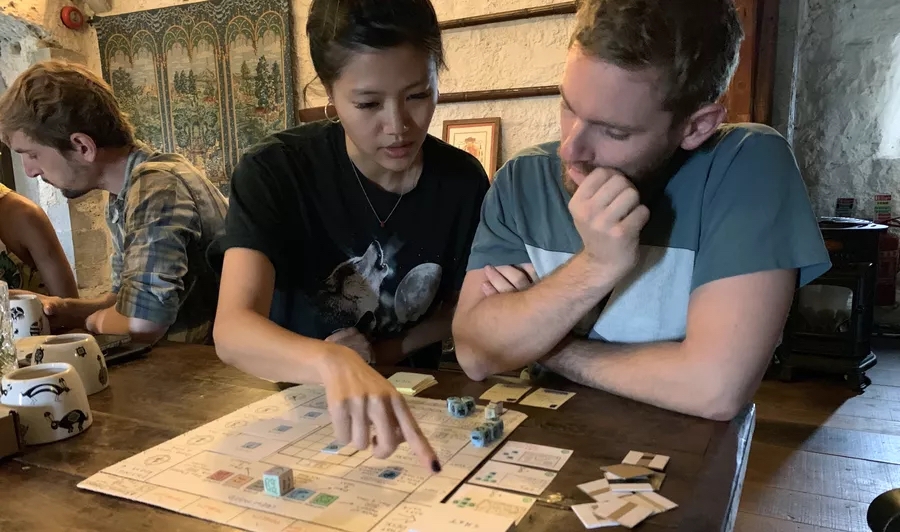
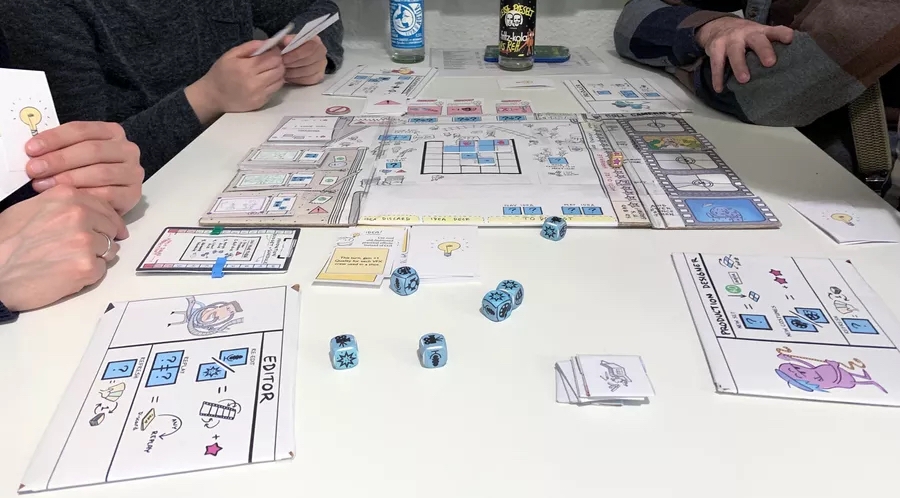
ENG | For the authors/illustrators who read us, could you give us some tips when launching their games through Kickstarter or other platforms?
Unless you know that your first few projects are going to be tiny, you need a following to run a crowdfunding campaign. I know that sounds like a non-starter for a lot of people. Not everyone has a following. But it was a non-starter for me, with regards to film. I never even considered doing a crowdfunding campaign for a movie, even though I was a filmmaker, because I didn’t have a following that was in that area. I only launched the Itchy Feet card game Kickstarter because I had already been doing the comic for 6 years and raised a considerable following.
Kickstarter is not an audience, it’s a platform, at least for small and first-time publishers. So you really need to work on that first. Another tip is, «write what you know.» That’s the classic screenwriting advice, and it applies to game design, too. Make a game about something you know about, something you are passionate about – ideally NOT something related to board games! Pirates, zombies, etc; unless you have a new angle or a different take, those things are played out in the hobby and you’ll be lost in the shuffle. Make a game about something you know a lot about, because that’s your «unfair advantage» in the marketplace.
ESP | Para los autores/ilustradores que nos leen, ¿podría darnos algunos consejos a la hora de lanzar sus juegos a través de Kickstarter u otras plataformas?
A menos que sepas que tus primeros proyectos van a ser minúsculos, necesitas tener seguidores para llevar a cabo una campaña de crowdfunding. Sé que a mucha gente eso le parece imposible. No todo el mundo tiene seguidores. Pero para mí no lo era, en lo que respecta al cine. Nunca me planteé hacer una campaña de crowdfunding para una película, aunque fuera cineasta, porque no tenía seguidores en ese ámbito. Sólo lancé el Kickstarter del juego de cartas Itchy Feet porque ya llevaba 6 años haciendo el cómic y había conseguido un número considerable de seguidores.
Kickstarter no es un público, es una plataforma, al menos para las editoriales pequeñas y primerizas. Así que hay que trabajar eso primero. Otro consejo es: «escribe lo que sabes». Es el consejo clásico de los guionistas, y también se aplica al diseño de juegos. Haz un juego sobre algo que conozcas, algo que te apasione… ¡lo ideal es que NO sea algo relacionado con los juegos de mesa! Piratas, zombis, etc.; a menos que tengas un nuevo punto de vista o una perspectiva diferente, esas cosas ya se usan en el hobby y te perderás en la confusión. Haz un juego sobre algo de lo que sepas mucho, porque esa es tu «ventaja injusta» en el mercado.
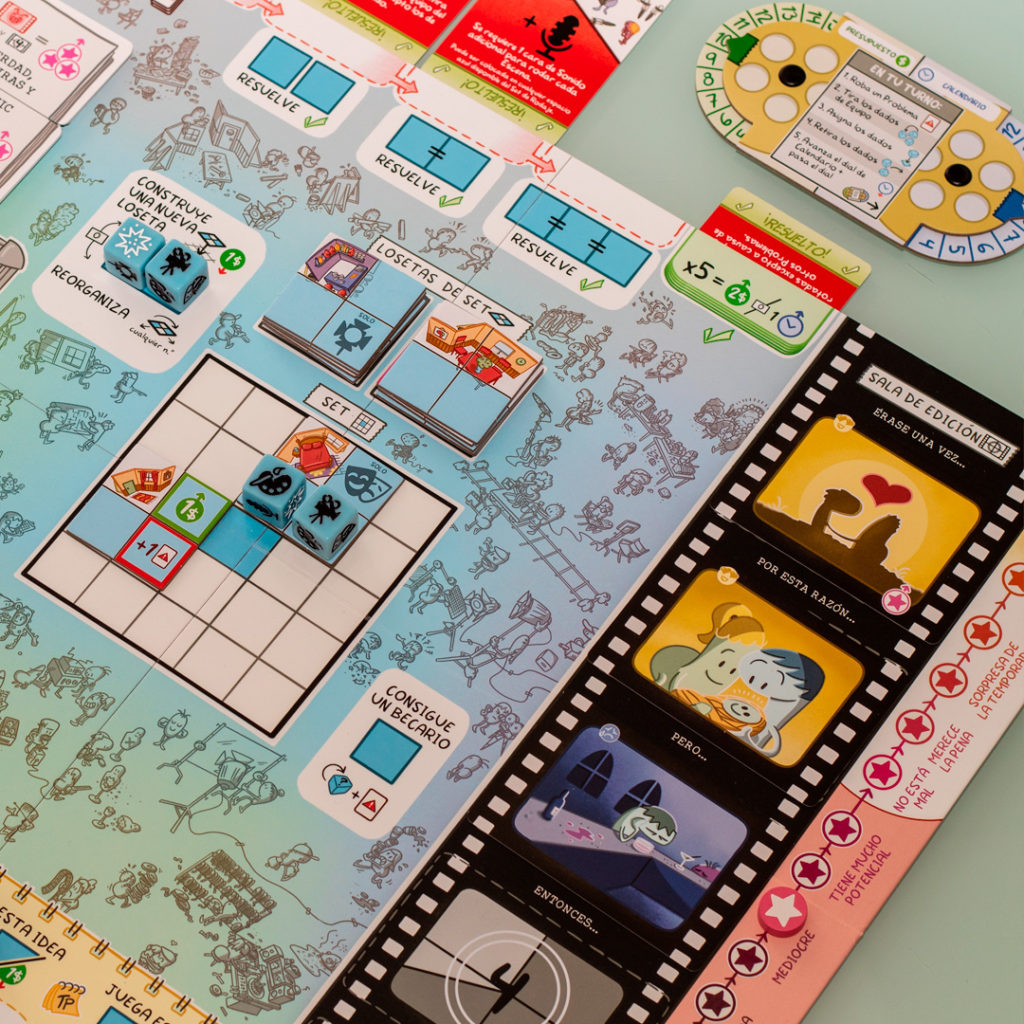
ENG | Finally, what projects are you currently working on and where can we follow your projects?
I’ve been working on some micro-expansions to Roll Camera – the first one, the Super Hero Story Pack, is available on my website along with Roll Camera and Itchy Feet. I’m working with John Velgus, the developer of the B-Movie Expansion, on some new Story Packs for release this year. And I’m deep in development on a strategy game called Almighty, about ancient gods competing to gain mortal followers and claim their souls into their underworlds. Ancient mythology is another passion of mine, so I’m hoping to bring some of that energy to life on the tabletop with Almighty; with bean-people of course.
You can join the Almighty Facebook group to get updates, or follow my design diaries on the Keen Bean Studio Discord channel.
ESP | Por último, ¿en qué proyectos está trabajando actualmente y dónde podemos seguirlos?
He estado trabajando en algunas micro-expansiones para Roll Camera: la primera, Super Hero Story Pack, está disponible en mi sitio web junto con Roll Camera y Itchy Feet. Estoy trabajando con John Velgus, el desarrollador de la expansión de B-Movie Expansion, en nuevos Pack de Historias que saldrán a la venta este año. Y estoy desarrollando un juego de estrategia llamado Almighty, sobre dioses antiguos que compiten por ganar seguidores mortales y reclamar sus almas en sus inframundos. La mitología antigua es otra de mis pasiones, así que espero llevar parte de esa energía a la mesa de juego con Almighty; con gente de las judías, por supuesto.
Puedes unirte al grupo de Facebook de Almighty para estar al día, o seguir mis diarios de diseño en el canal de Discord de Keen Bean Studio.
Muchas gracias Mal 😉
(Todas las imágenes cedidas por Malachi Ray Rempen)

